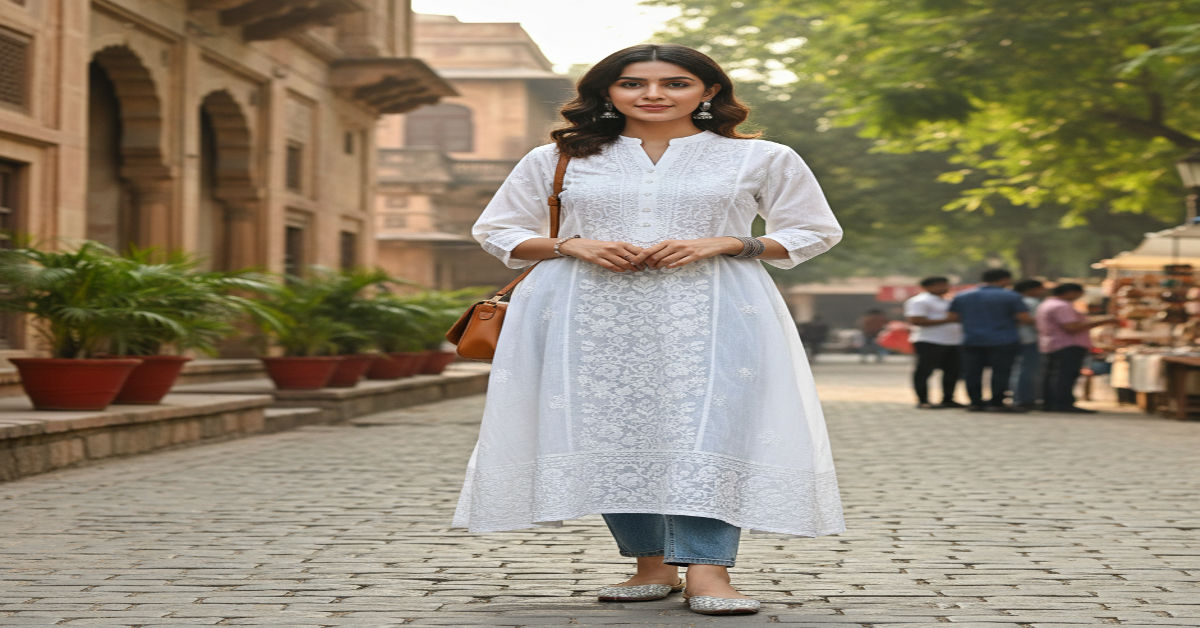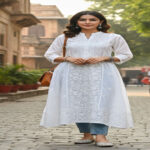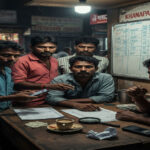Within the first hundred words, it’s clear why the chikan kurti has captivated women globally: it embodies an intricate, hand-embroidered tradition while seamlessly fitting into modern wardrobes. Originating from Lucknow, India chikan embroidery is one of the oldest forms of needlework, dating back several centuries and has evolved from royal court attire to a contemporary fashion staple. Women across urban and rural India—and increasingly abroad—choose chikan kurtis for their elegance, comfort and versatility. From casual workwear to festive gatherings, this attire balances heritage with style, appealing to a broad demographic of fashion-conscious individuals.
The enduring charm of the chikan kurti lies in its meticulous handwork, often completed by skilled artisans over weeks, sometimes months, depending on the complexity of the design. Unlike mass-produced fashion, each piece carries a unique signature, merging culture, artistry, and functionality. As global interest in sustainable and handcrafted fashion grows, the chikan kurti exemplifies a garment that is both culturally resonant and economically significant, providing livelihoods for thousands of artisans. This article investigates its historical origins, contemporary relevance, and the challenges and opportunities facing the craft today, offering insights from industry experts, designers, and cultural historians.
The Art and Technique of Chikan
Chikan embroidery is characterized by its delicate floral patterns, paisleys, and intricate geometrical motifs, traditionally executed on soft fabrics such as muslin, cotton, silk, or chiffon. The embroidery involves several unique stitches, including bakhiya, phanda, murri and tanki, each serving distinct decorative and structural purposes. What makes chikan distinctive is its sheer elegance; patterns are subtly raised, providing a textural interplay that catches light without overwhelming the wearer.
| Stitch Type | Description | Typical Use |
| Bakhiya | Shadow stitch on the wrong side of fabric | Floral motifs |
| Phanda | Knotted stitch creating small bumps | Filling patterns |
| Murri | Small raised stitch resembling grains | Borders and outlines |
| Tanki | Satin-like stitch for smooth curves | Detailing |
Fashion designers emphasize that combining these stitches with modern cuts—such as high-low hems, cape sleeves, or flared silhouettes—creates a contemporary aesthetic while respecting tradition. This delicate balance between heritage and innovation is critical for appealing to younger consumers who value cultural authenticity alongside fashion-forward design.
Market Dynamics and Global Appeal
The popularity of chikan kurtis is not limited to India. Over the past decade, international demand for hand-embroidered, sustainable fashion has surged. Countries such as the United States, Germany, and Japan increasingly source chikan kurtis through online marketplaces and export networks. According to the Ministry of Textiles (India, 2023), the export value of handloom products, including chikan, has risen by 12% annually over the last five years.
| Year | Domestic Sales (INR Crores) | Export Value (INR Crores) |
| 2019 | 1,200 | 350 |
| 2020 | 1,350 | 400 |
| 2021 | 1,480 | 450 |
| 2022 | 1,620 | 500 |
| 2023 | 1,780 | 560 |
Experts such as Rina Kapoor, Creative Director at Indian Fashion Council, note that “the global appeal of chikan kurtis lies in their understated luxury. International buyers are drawn not just to the craftsmanship but also to the narrative of cultural heritage and sustainability.”
At the domestic level, urban consumers increasingly choose chikan kurtis for both workwear and casual occasions. “Younger women appreciate the versatility of these garments. You can wear a chikan kurti with jeans for a relaxed look or with a skirt for festive events,” says textile consultant Prakash Mehra. This dual functionality strengthens the garment’s position in modern wardrobes.
Sustainability and Ethical Fashion
Handmade chikan kurtis naturally align with sustainable fashion principles. Unlike fast fashion, each piece is meticulously crafted without heavy industrial processes, significantly reducing energy consumption and chemical usage. Moreover, supporting artisans ensures economic sustainability in vulnerable communities. Dr. Maria Lopez, Behavioral Economist at Harvard, emphasizes, “Purchasing authentic chikan embroidery is not merely a fashion choice it is an investment in cultural preservation and ethical labor practices.”
Challenges remain, including balancing scalability with artisan welfare. Cooperatives and NGOs are helping artisans achieve fair wages while expanding production capacity. This shift represents a growing awareness among consumers that authentic, handcrafted fashion is both socially responsible and aesthetically enriching.
Style and Versatility
Chikan Kurti for Women have evolved beyond traditional pastels and whites. Designers now experiment with vibrant colors, embroidered borders, sequins, and layering techniques while retaining signature hand-stitched patterns. Women wear chikan kurtis in multiple contexts—from office meetings to weddings, casual weekends, and cultural events.
Fashion editor Anjali Mehta observes, “Chikan kurtis offer a unique intersection of comfort, style, and cultural identity. They suit diverse body types and work well in both formal and informal settings. The handwork is subtle enough for everyday wear yet elegant enough for celebration.”
By merging classic embroidery with modern silhouettes the garment bridges generations, connecting the past with contemporary sensibilities. This adaptability explains why chikan kurtis remain a mainstay in both Indian and global fashion.
Economic and Social Impact
The Chikan Kurti for Women industry provides income for tens of thousands of artisans, many of whom are women. Hand embroidery offers a pathway to financial independence, skill development, and intergenerational knowledge transfer. Government initiatives such as the “One District One Product” program in India have further promoted chikan as a cultural export, bolstering regional economies and global recognition.
Economist Suresh Jain explains, “Supporting chikan artisans has a multiplier effect. It preserves cultural heritage, generates employment, and boosts small-scale entrepreneurship.” By choosing handcrafted garments, consumers contribute to a sustainable value chain and empower artisan communities.
Key Takeaways
- Authentic chikan kurtis are hand-embroidered and use multiple specialized stitches, creating unique, textured designs.
- The craft has centuries-old roots, originating in Mughal-era Lucknow, yet continues to evolve with modern fashion trends.
- Chikan embroidery supports thousands of artisans, particularly women, promoting financial independence and cultural preservation.
- Global demand is growing, driven by sustainability, ethical fashion, and the narrative of heritage.
- Modern adaptations include vibrant colors, contemporary silhouettes, and functional versatility for casual and formal wear.
- Investing in authentic chikan supports traditional craftsmanship over mass-produced alternatives.
- Sustainability and ethical labor practices make chikan kurtis a socially responsible fashion choice.
Conclusion
The Chikan Kurti for Women is more than a garment it is a living cultural artifact, a testament to centuries of meticulous craftsmanship, and a bridge between tradition and modern fashion sensibilities. Its enduring popularity reflects not only aesthetic appeal but also ethical and economic significance. As the fashion industry shifts toward sustainability and global consumers increasingly value handcrafted artistry, chikan kurtis stand at the intersection of heritage and contemporary style. By understanding their historical context, production intricacies, and socio-economic impact, women around the world can appreciate these garments not merely as clothing, but as wearable art that embodies resilience, creativity, and cultural identity.
FAQs
Q1: What fabrics are typically used for chikan kurtis?
Chikan embroidery is traditionally done on muslin, cotton, silk, chiffon, or georgette, which allow delicate hand-stitches to shine.
Q2: How can I identify authentic chikan work?
Look for fine, hand-embroidered patterns with even but slightly irregular stitches, soft fabric, and a light, textured feel.
Q3: Are chikan kurtis suitable for casual wear?
Yes, they are versatile. Pair with jeans, leggings, or skirts for casual, office, or festive occasions.
Q4: How long does it take to make a chikan kurti?
Depending on the complexity, it can take from several days to weeks for a single artisan to complete a hand-embroidered kurti.
Q5: Where can I buy ethically made chikan kurtis?
Purchase from certified cooperatives, NGOs supporting artisans, boutique stores, and trusted e-commerce platforms that verify handmade authenticity.







